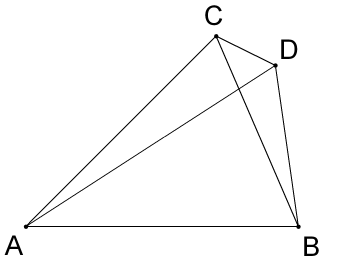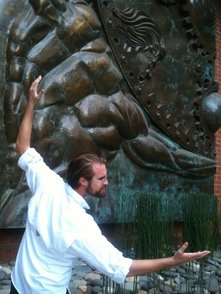Ah, Euclid you're like a Guardian Angel watching over us. Ingrid asked us if we could construct the given triangles in Proposition 4, Book I. It became chaos, believe me. People went crazy, some shut their ears, some didn't understand what was happening. But at the end we decided to divide in groups to make this work. So, now we're divided in 3 groups. My group is Marce, Kata, Carmen, Grace and I. We decided to accomplish certain standards (these were the core of them):- Drawings have to be understood in our notebook.
- Logical structure
- Rhetoric and understandable explanation
Pablito presented Proposition 7 today. His presentation was beautiful, I got more excited with Euclid! Again, Euclid is conquering my heart.
Given two straight lines constructed on a straight line (from its extremities) and meeting in a point, there cannot be constructed on the same straight line (from its extremities), and on the same side of it, two other straight lines meeting in another point and equal to the former two respectively, namely each to that which has the same extremity with it.
This is the proposition. One of the cases (the one we worked) is like this:

Taken from: http://www.ashleymills.com/euclid_1_7
I got some "Aha moments", and understood Euclid perfectly. Now, this is what social cooperation means! It would've been even more fruitful if absolutely everyone had said their thoughts.
Amazing. Thanks Pablito.
We presented today Proposition 11 through 16.
The class was divided in two: those who didn't understand the first propositions and the others that were on track.
It was productive for both of the sides, and we made a great progress.
We took 3 papers out of the hat in order to explain Propositions 4, 5 and 6. The presentation were not the best, I would say. We had a really hard time, even though I stood up in order to explain the propositions, they were not a dance. They were not fluent.
We have so much to work in commitment.
We recorded Euclid's Propositions 1, 2, and 3. It was a real challenge. Maintaining the presentation clear, quick and beautiful was a challenge (the students are all handsome, don't misinterpret.). But, I have to say I got kind of frustrated at the beginning, because the proposition I had to present, the second, is really long. I got confused with the continuity of the alphabetical pattern when making circles. I have some issues with "perfectionism". I can't end up something if it turns up the other way around as expected. So I presented my first draft of the videos for Euclid's presentation and it went pretty well. This is the feedback I received: - Be careful with the camera and the set (movements that go off the screen)
- Be nice. (I accept I was kind of frustrated.)
- Work on visual precision (the graphics weren't so accurate)
- Not covering my face with the paper that has the proposition written on it.
- I was clear, apparently :)
Our small group (Lucia, Javier Tabush and I) presented yesterday the first 3 propositions of Euclid. It was kind of difficult at first, but we managed to get through the propositions. We need to work on eloquence and focusing to the topic.
We have to work on the rubric of getting things done. We did get this done, but it is still a challenge. We have to make this work! :)
Today was so much fun. Katarina, Franz and I presented the first proposition of Euclid's Elements. We were prepared because we met with Andrew Humphries before for a couple of times. We were trying to solve the propositions without looking at the picture, and just following the procedure. Euclid is a genius!
It's necessary to actually understand Euclid's definitions, postulates and common notions before getting to the propositions. The logic behind them is amazing and it impresses me how there isn't a single number in a problem in the whole book.
I have to work with my communication while presenting though, it's an important phase of my learning process.
Another thing is that we need to have a different set of rules when we are discussing Euclid, because he needs to be understood and besides there are some rules of the dialogue that are really general, rules like "Not cheating on the drawing" would be cool.
Andrew Humphries, a graduate from St. John's College Skyped with us today and talked about his experience studying Euclid. He mentions how Euclid looks at the foundations, and how, in order to study Elements, one most forget about everything we already think we know.
It's funny, because in school we're taught to see geometry immediately related with numbers. But Euclid doesn't use numbers in his propositions! Besides, he writes almost everything. What a different approach.
Funny thing is that previously, we read a John Stuart Mill's quote which referred to how questioning every propositions is actually a step if we want to acquire understanding. Euclid is proposing his views, and the process to prove those is very clear. "His logic is really sharp" mentioned Humphries. Even though, I wish Euclid will get to answer all of our questions.
We had a Skype session with Andrew Humphries today.
He is a great learner, and he studied in St. John's College. There, he learned Euclid.
In order to understand Euclid, we have to look at the foundations was one of the things he shared with us. Also, reading Euclid will be a great challenge because he is actually talking us in a language, and that language is one with definitions and rules one must follow in order to understand. Also, the logic behind Euclid's work is amazing. It is a cool experience, and I could here out from Andrew's words that it will be fun!
Euclid is a mad genious, of that I'm certain. Today in the Michael Polanyi College, we went through different concepts that Euclid gave before starting his famous work : Elements.
The dialogue was intense. It is absolutely interesting what a great conversation can be brought up out of Euclid's statement:
"A point is that which has no part."
We all had to let go of our established concept of what a point is. It definitely exists, it is the one that delimitates lines. Even if it has no part it just settles an end and a beginning.
There is a point here >___________________ < and a point there.
You don't see it but it's there.
We also got to the concept "surface", and it's amazing how hard the transition from a 3D to a 2D world is.
This will be exciting.
|




 RSS Feed
RSS Feed